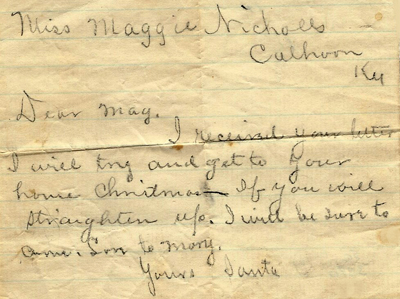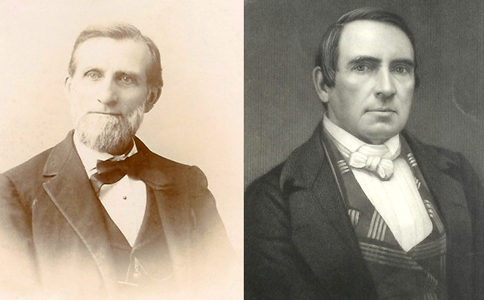As the question, “What are you doing for the holidays?” begins to spread over the land, here are a few past glances at Christmas Day as experienced by Kentuckians and others represented in WKU’s Department of Library Special Collections. Despite their lack of TV, video games, opening day movies and other distractions, it is surprisingly easy to empathize with their preoccupations and reflections.
One concern, of course, was the weather. December 25, 1844 in Caswell County, North Carolina, dawned “a most Beautiful clear & pleasant morning,” according to one anonymous observer, “the ground a little crusted tho the Sun shines Bright and warm at 9 oclock in the morning.” Closer to home, Bowling Green’s John Younglove recorded the temperature at sunrise on Christmas Day as part of his faithful meteorological record. His readings ran the gamut from a frosty 6 below zero in 1878 to a rainy 54 degrees in 1889.
Some Kentuckians have made Christmas Day doubly memorable: for example, George W. Shanks and Catharine Johnson, both of Galloways Mill in Warren County, chose December 25, 1881 as their wedding day.
For those in military service, unfortunately, December 25 might be barely distinguishable from other days. “There was not much here in a Christmas nature,” wrote Army dentist Bill Fulton from Fort Knox in 1942. “Here we are in the Army and know nothing else.” But Marshall Cole, serving in the Philippines in 1944, found himself having a better Christmas Day than he expected, thanks to gift boxes from the Red Cross and fresh turkey for dinner.
For children, letter writing more commonly took the form of communiques to Santa Claus. Saint Nick’s replies to young Maggie Nicholls of Calhoun, Kentucky, however, looked like they might have been ghostwritten by a Victorian parent. “I will try to get to your home Christmas,” he promised. “If you will straighten up I will be sure to come.” And in 1881, her gifts arrived with instructions to take good care of them, love her parents, and “always sit still at the table.”
Other Christmas Day letters gave their writers a welcome opportunity to reconnect with those dearest to them. On December 25, 1865, a young man in Union County, Kentucky, replied eagerly to a letter from his father, with whom he had been out of touch for almost two years. Bringing him up to date on his teaching and preaching duties at two small churches, he reflected on the “demoralization in society that is quite visible everywhere,” with increasing crime and intemperance and a decline in church attendance, especially outside the South.
On December 25, 1848, Ann Rowan Buchanan, the daughter of John Rowan of Federal Hill (“My Old Kentucky Home”) penned a letter to her mother from Cincinnati. The weather was gloomy and cold, and her husband appeared unwilling to let the holiday interfere with his business activities. Nevertheless, Ann’s heart was full. The mother of three boys under six years of age, she found joy in their eager wait for Santa and their excitement at finding their stockings full. Remembering her own girlhood Christmases, she had resolved to continue the tradition. The “cares and troubles of life may break us down,” she wrote her mother, but “one verdant spot still remains ever green, which blooms to the grave, a Christmas day in our childhood.” For her children, she would “do my best to make them happy on this day that may be a green spot in their hearts in after years as it is in mine.”
Click on the links for finding aids and other information about these Christmas Day items in the Manuscripts & Folklife Archives collections of WKU’s Department of Library Special Collections. For more collections, search TopSCHOLAR and KenCat.



